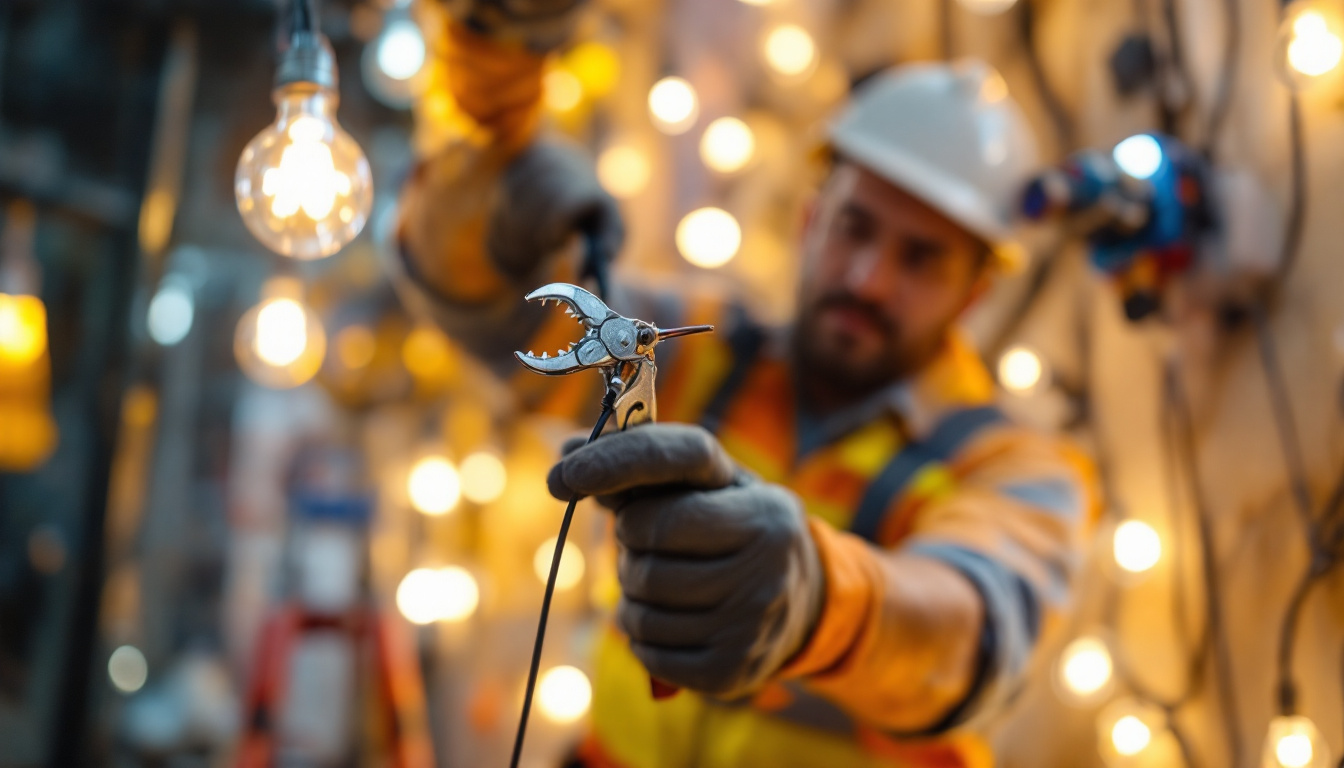

In the ever-evolving world of lighting solutions, LED canister light bulbs have emerged as a staple for lighting contractors. These versatile fixtures not only provide energy efficiency but also enhance the aesthetic appeal of various spaces. Understanding their features, benefits, and installation techniques is crucial for contractors aiming to deliver top-notch lighting solutions to their clients.
LED canister light bulbs, often referred to as recessed or downlight fixtures, are designed to be installed in ceilings or walls, providing a sleek and unobtrusive lighting option. Unlike traditional bulbs, these fixtures are integrated into the structure, allowing for a clean and modern look. They come in various sizes, shapes, and color temperatures, making them suitable for a wide range of applications. The versatility of LED canister lights means they can be used in residential settings, such as living rooms and kitchens, as well as in commercial environments like offices and retail spaces, where effective lighting is crucial for ambiance and functionality.
When selecting LED canister light bulbs, it’s essential to understand the different types available. Generally, they can be categorized into several types based on their design and functionality:
Each type serves a unique purpose, and understanding these differences can help contractors recommend the best options for their clients’ needs. For instance, adjustable lights are particularly beneficial in spaces where artwork is displayed, as they can highlight the pieces effectively, enhancing the overall aesthetic of the room. Meanwhile, smart LED options provide an added layer of convenience, allowing users to adjust brightness and color temperature to suit different moods or activities, from a bright, energizing light for work to a warm, relaxing glow for evening gatherings.
LED canister light bulbs offer numerous advantages over traditional incandescent or fluorescent lighting. Here are some key benefits that lighting contractors should consider:
These benefits make LED canister light bulbs an attractive option for both residential and commercial projects, ensuring that contractors can provide energy-efficient solutions to their clients. Additionally, the reduced environmental impact of LED lighting cannot be overlooked; by choosing LED canister lights, clients contribute to lower carbon footprints and support sustainable practices. Furthermore, many LED options are now available with dimming capabilities, allowing for greater control over lighting levels, which can enhance comfort and productivity in various settings. As the demand for energy-efficient solutions continues to grow, LED canister light bulbs stand out as a forward-thinking choice in modern lighting design.
Proper installation is crucial for maximizing the performance and longevity of LED canister light bulbs. Here are some essential considerations that lighting contractors should keep in mind:
The placement of canister lights can significantly impact the overall lighting effect in a space. Contractors should consider factors such as:
Taking the time to evaluate these factors can lead to a more successful lighting project and increased client satisfaction. Additionally, it’s beneficial to consider the natural light sources in the room. For instance, rooms that receive ample sunlight during the day may require less artificial lighting, allowing for a more balanced approach to illumination. Furthermore, using a combination of canister lights with other lighting sources, such as wall sconces or table lamps, can create a layered lighting effect that enhances the ambiance of the space.
Before installation, it’s essential to assess the electrical requirements of the chosen LED canister light bulbs. Key points to consider include:
Addressing these electrical considerations upfront can prevent potential issues during installation and ensure a smooth process. Moreover, it’s wise to conduct a thorough inspection of the existing electrical system to identify any outdated wiring or potential hazards that could affect the performance of the new fixtures. Implementing energy-efficient practices, such as using LED drivers that minimize energy loss, can further enhance the sustainability of the lighting installation. By prioritizing these electrical aspects, contractors can not only ensure safety but also optimize the energy efficiency of the lighting system, which is increasingly important in today’s eco-conscious market.
The color temperature of LED canister light bulbs plays a significant role in setting the mood and functionality of a space. Measured in Kelvin (K), color temperature can range from warm (below 3000K) to cool (above 5000K). Understanding how to select the appropriate color temperature is essential for lighting contractors.
Warm white light (2700K-3000K) is often preferred for residential settings, creating a cozy and inviting atmosphere. It’s ideal for living rooms, bedrooms, and dining areas. In contrast, cool white light (3500K-4100K) is suitable for workspaces and kitchens, providing a bright and energizing environment.
Daylight white (5000K-6500K) mimics natural sunlight and is often used in commercial settings or areas where task lighting is essential. Understanding these preferences can help contractors make informed recommendations to their clients.
The Color Rendering Index (CRI) is another critical factor to consider when selecting LED canister light bulbs. CRI measures how accurately a light source displays colors compared to natural light. A higher CRI (above 80) is generally preferred for residential and retail spaces, as it enhances the appearance of colors and textures.
Contractors should educate their clients about the importance of CRI in creating visually appealing environments, especially in settings like galleries, showrooms, or homes with significant artwork.
While LED canister light bulbs are known for their longevity, regular maintenance is still essential to ensure optimal performance. Lighting contractors should provide clients with guidance on how to care for their fixtures.
Dust and debris can accumulate on the surface of canister lights, reducing their brightness and efficiency. Regular cleaning can help maintain their performance:
Encouraging clients to include light fixture cleaning in their regular home maintenance routine can prolong the lifespan of their LED canister lights.
Contractors should advise clients to monitor the performance of their LED canister lights. If any fixtures flicker, dim, or fail to turn on, it may indicate an underlying issue that needs to be addressed. Quick troubleshooting can prevent further complications and ensure that clients enjoy consistent lighting quality.
The lighting industry is continuously evolving, with new trends emerging regularly. Staying informed about these trends can help lighting contractors provide cutting-edge solutions to their clients.
As smart home technology becomes increasingly popular, integrating LED canister lights with smart systems is a growing trend. These fixtures can be controlled remotely, allowing users to adjust brightness, color temperature, and even create lighting schedules through mobile apps or voice commands.
Contractors should familiarize themselves with various smart lighting options and educate clients on the benefits of incorporating these technologies into their lighting designs.
With a growing emphasis on sustainability, many clients are seeking eco-friendly lighting solutions. LED canister light bulbs are inherently energy-efficient, but contractors can further enhance their sustainability efforts by recommending fixtures made from recyclable materials or those that have a minimal environmental impact during production.
By aligning with sustainable practices, contractors can attract environmentally conscious clients and contribute to a greener future.
LED canister light bulbs have become an essential component of modern lighting design, offering energy efficiency, versatility, and aesthetic appeal. For lighting contractors, understanding the various types, benefits, installation considerations, and trends in LED canister lighting is crucial for delivering exceptional service to clients.
By staying informed and adapting to the evolving landscape of lighting technology, contractors can position themselves as trusted experts in the field, ensuring that their clients receive the best possible lighting solutions for their spaces. Whether working on residential or commercial projects, the knowledge of LED canister light bulbs will undoubtedly enhance the quality of work and client satisfaction.
Ready to elevate your lighting projects with the efficiency and elegance of LED canister light bulbs? Look no further than LumenWholesale, where we specialize in providing contractors with high-quality, specification-grade lighting products at unbeatable wholesale prices. Say goodbye to local distributor markups and hello to a vast selection of industry-standard lighting solutions that promise reliability and high performance for any project. With the added convenience of free shipping on bulk orders, LumenWholesale is your go-to source for premium lighting without hidden fees or compromises. Wholesale Lighting at the Best Value is just a click away—transform your lighting approach with us today.

Discover the essential insights and strategies for lighting contractors in “Wire Pullers: The Points for Lighting Contractors.” This article delves into the latest industry trends, innovative techniques, and practical tips to enhance your projects and boost client satisfaction.

Discover the transformative impact of LED lamp fixtures through compelling real-world success stories.

Explore the intricate world of bay lighting as we uncover common oversights made by contractors.

Discover the essential guide for lighting contractors on the integration of sensors and timers.
Get notified when NEW deals are released.
Optimize your budget with wholesale discounts.
Only top-quality, specification-grade lighting products.
No additional costs at checkout - what you see is what you pay.
We understand the unique needs of contractors.